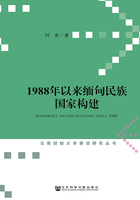
Abstract
This Paper researches the Myanmar's nation-building since 1988, which actually is concerned with three major aspects: firstly, the state-building with“government decree and military order unification”as the main content handled by the Myanmar's central government; secondly, the nation-building integrating multi-nationalities in its territory into a nation as the main content pursed by the Myanmar's central government; and thirdly, the national identity of the minority nationalities that gradually increases in the course of interaction in the nationbuilding and state-building promoted by the Myanmar's central government, although they have sharp contradictions and conflicts with the central government. In this paper, national politic theories are applied to have a deep and systematic analysis to the Myanmar's nation-building since 1988, to probe the reason for the gradual increase of national identity of the minority nationalities since 1988,to fully discuss the history, status quo, challenges, prospects, general trend,etc. of the Myanmar's nation-building.
The Paper consists of an introduction, five chapters and a conclusion.
The introduction deals with the origin of the subject matter, significance of research, major conceptions, framework of theories, research methodologies, innovative reflections as well as the research status quo of this subject matter.
Chapter One firstly introduces Aung San's theory and practice of“unity in diversity”on nation-building, which has promoted the establishment of nationstate. Then it explores the policies on nation-building advocated by U Nu and Ne Win. This Paper argues whether the U Nu government's political integration by means of weakening minorities' rights and strengthening the power of the federal government and the national assimilation, by means of taking Buddhism as state religion and adopting unified national cultural policy, or the Ne Win government's policy that cracks down anti-government armed groups with strength and enhances the centralization and Myanmarization, because of overlooking the primordial emotion of the minorities and depriving of their national rights, is in the teeth of widespread opposition by the minorities, as a result,they have established their own ethnic armed forces against the central government, finally putting Myanmar's national-building into the lurch.
Chapter Two elucidates the enhancement of the national identity of the minorities reflected by the changes of the national political targets of the minorities’ armed forces since the independence of Myanmar, especially since 1988 with the method of actual statistical data. Statistics shows that, before new military regime came to power in 1988, there had been 19 minority armed forces in Myanmar intended to found their own independent states. After 1988, though their contradiction with the central government of Myanmar was not solved, even the armed conflicts between them occurred, they abandoned their intention to found their own independent states any longer; instead, they requested the high degree of autonomy including legal armed force under the framework of national sovereignty.
Chapter Three mainly probes into the reasons for the enhancement of national identity of the minorities. Since 1988, the main minorities' armed forces have almost been abandoning their political demands of founding an independent state; instead, most of them have kept pursuing high degree of national autonomy. According to the author, the inner power of such a shift is that the central government and the minorities' armed forces have to consider their own actual benefits. The internal impetus was that the military government actively pushed forward the political reconciliation policy towards the minorities' armed forces in order to promote nation-building. The minorities hoped to get high degree of national autonomy including reserving forces. The external condition was that the regional peace prevailed, especially, the neighboring countries such as China, Thailand and other neighboring countries abandoned the consciousness of Cold War, adjusting the policy to the minorities' armed forces of Myanmar, almost gave up the way of taking the minorities' armed forces of Myanmar as buffer forces or interfering with the internal affairs of Myanmar with such minorities' armed forces, in order to realize economic and social development.
Chapter Four briefs the background and content of the 2008 Constitution and the Border Guard Force Plan of“government decree and military order unification”in accordance with such Constitution; then this chapter emphatically analyzes the leading position of the military in the nation and state building empowered by the Constitution and the nation and state building reflected in such Constitution.
Chapter Five firstly discusses the possible challenges in Myanmar's nation and state building in the future and then analyzes the opportunities thereof. This Paper argues that, the military junta having retired backstage may challenge the nation and state building if its interest cannot be guaranteed. NLD's dominance in the future will make the losers in the competition of state power take more radical measures to capture votes, regardless of national unity. The minorities’ higher political demands may also affect the nation and state building. Although Myanmar's nation-building faces many challenges, there are still numerous opportunities such as Aung San Suu Kyi's calling for on national reconciliation, the minorities' armed forces' positive response to the government's peace initiative,as well as the giant neighbors' supporting Myanmar's national reconciliation. This Paper also argues that despite Myanmar's nation and state building will meet a lot of challenges and difficulties, but the completion of integrating multiethnic groups into unified nation will be general trend for Myanmar.
The Conclusion offers a systematic summary and reflection on the salient features of Myanmar's nation and state building, the reasons for the enhancement of Myanmar's minorities' national identity, and the challenges, opportunities and trend of Myanmar's nation and state building.